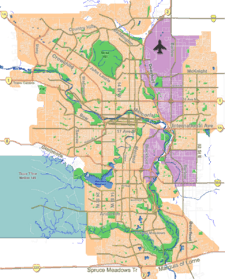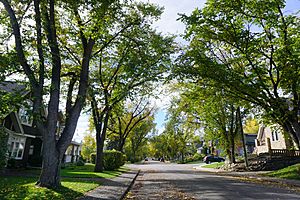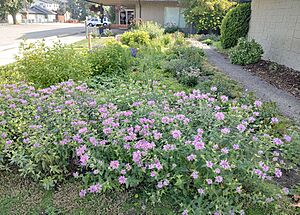Parkdale, Calgary facts for kids
Quick facts for kids
Parkdale
|
|
|---|---|
|
Neighbourhood
|
|
| Country | |
| Province | |
| City | [[File:|22x20px|border |alt=|link=]] Calgary |
| Quadrant | NW |
| Ward | 7 |
| Established | 1948 |
| Annexed | 1910 |
| Area | |
| • Total | 0.6 km2 (0.2 sq mi) |
| Elevation | 1,060 m (3,480 ft) |
| Population
(2012)
|
|
| • Total | 2,962 |
| • Average Income | $71,335 in 2,010 |
| Time zone | UTC−7 (MST) |
| Postal code |
T2N 2V3
|
| Area code(s) | 403 |
Parkdale is a neighborhood in Calgary, Alberta, located along the north side of the Bow River. It sits between the communities of West Hillhurst and Point McKay. The neighborhood is bordered by the Bow River to the south, 28 St NW to the east, Shaganappi Trail NW to the west, and 16th Avenue to the north.
Parkdale is very close to important places like the Foothills Medical Centre and the Alberta Children's Hospital, which was built in 2006. It's also near the University of Calgary. A road called Memorial Drive helps people get to downtown Calgary and to Highway 1, which leads to the amazing Rocky Mountains.
Parkdale became part of Calgary in 1910 during a big time of growth for the city. After World War II in the 1950s, many homes built in Parkdale were bungalows (single-story houses). By 2014, Parkdale started to change. Older, smaller bungalows were replaced by newer, larger homes. These new homes often have flat roofs and are inspired by the Prairie School style of Frank Lloyd Wright. This change, called gentrification, attracts young families who want to live closer to downtown, public transport, and work, instead of commuting from far-away suburbs.
Parkdale is represented in the Calgary City Council by the Ward 7 councillor, Terry Wong. He started his first term after being elected in 2021.
Contents
Parkdale's Past: A Look at Its History
Early Growth and Development
Parkdale became part of Calgary in 1910 when the city was growing quickly. By 1911, two streetcar lines made it easier to reach the quiet Parkdale community. One line went through Parkdale to Bowness, and another had its end point in Parkdale.
In 1911, Alfred S. McKay and other real estate developers created a new area called Parkdale Addition. They wanted to build a neighborhood for professionals, close to the streetcar lines. Between 1911 and 1913, they built several houses, including some beautiful heritage homes that still stand today.
By 1912, about 12 houses or farms were in Parkdale as farmers began to settle there. One of the very first houses, built in 1910, was a farmhouse that is still lived in by the same family today.
Building Homes After the War
After World War II, in April 1950, a surveyor planned out lots for new homes in Parkdale. Many of these homes were "Wartime Housing Models," also known as Victory Housing. These were simple, cheap homes built quickly to house workers during the war. Many of these houses are still around today.
In the 1950s, a company called Keith Construction built 130 homes in Parkdale. By 1951, 13 of these new homes were already occupied.
New Schools and Green Spaces
In 1952, the Calgary Board of Education opened the Parkdale Elementary School. It was a large, modern school and the biggest of four schools opened that year. A newspaper article from 1952 described Parkdale as a "new and rapidly populating district."
Along with the new school, city planners also set aside land for local businesses and green spaces. This area is now where the Parkdale Community Association complex, the Parkdale Community Garden, and the Gathering Place are located.
Calgary had another big growth period from 1972 to 1982, when oil prices went up. The city's population grew a lot during these years.
In the 1970s, the Point McKay condominium development was built east of Parkdale. This replaced an old drive-in movie theater.
Protecting the Riverfront
In the 1980s, the city wanted to build a big highway along the Bow River in Parkdale. But the community worked together and stopped it! Instead, the jogging and bike path along the Bow River pathway was improved. By 2014, this pathway system was very popular, running through Parkdale and connecting to the Peace Bridge and the Harry Booth bridge.
Modern Changes and Redevelopment
By 2014, Parkdale, like other inner-city communities in Calgary, was seeing a lot of redevelopment. Older, smaller homes were being torn down and replaced with larger single-family homes, duplexes, or even small condo projects.
This change means that more families with children are moving into the area. This helps inner-city schools and community centers become busy again. For example, Parkdale Elementary School, which closed in 2002, reopened in 2011 as Westmount Charter School moved its campus there.
New homes in these areas can be quite expensive. Despite all the new development, Parkdale has kept its "Lazy Loaf block," which refers to Parkdale Crescent, a local shopping area planned in the 1950s.
Parkdale Community Heritage Inventory
In 2008, the City of Calgary and the Parkdale Community Association started a project to find important historical places in Parkdale. They found ten places that were added to the City of Calgary's list of historic resources. They also found 28 other places that might have historical value, either for their natural history, archaeology, or architecture.
Green Spaces and Outdoor Fun
The Bow River "riverfront" runs along the entire Parkdale community and is its most important green space. In the 1950s, city planners made sure to include recreational green spaces in Parkdale. This land is now home to the Parkdale Community Association building, a playground, a baseball diamond, a rink, and the Parkdale Garden and Gathering Place. The Garden hosts fun events like the Medieval Fair.
In 2021, a special "rain garden" was built in Parkdale. It helps collect rainwater from the community's buildings.
The Parkdale/West Hillhurst Helicopter Playground is a great spot for kids. It has two large play structures with slides, a helicopter climber, a dinosaur climber, and a teeter-totter. There's also a big grassy area perfect for flying kites and a baseball diamond.
Parkdale Community Association
The Parkdale Community Association is a group that helps make Parkdale a great place to live. They:
- Publish a Community Newsletter to keep everyone updated.
- Manage the Parkdale Community Garden and Gathering Space.
- Host a Parkdale Farmers Market.
- Have a special subcommittee that helps with planning and development in the area.
Parkdale Plaza: Art and Nature
"This part of the city's stormwater system has been turned into an upside-down model of Mount Peechee. It reminds us of how the Bow River started from glaciers. When we see stormwater flow from the community, through this art, and into the Bow River, we understand the river's journey and how our actions affect its health. Together, Outfall and Parkdale Plaza show the delicate balance between our natural water system and the buildings around us."
In 2009, the City of Calgary started planning the Parkdale Plaza, which opened in 2014. It's located on the Bow River trail and offers great views of the Douglas Fir Trail and Edworthy Park and Calgary's downtown skyline.
The Plaza is built where the city's underground stormwater system empties into the Bow River. This system helps prevent flooding by directing rain and melted snow into rivers and creeks.
A unique sculpture called "Outfall" is part of the Plaza. It was designed by New York artist Brian Tolle. This sculpture is an upside-down, scaled-down model of Mount Peechee, a mountain north of Canmore, Alberta. It acts like a special pond that holds extra water during heavy rainstorms. This allows visitors to see how water moves through the system.
Ancient Discoveries in the Area
Just west of Parkdale, during the building of McKay Towers, archaeologists found two ancient campsites. These sites date back about 4600 and 4000 years ago! They also found more recent "tipi rings," which are circles of stones used to hold down the edges of tipis.
Two historical sites were also found: one might have been a Métis camp, and another showed signs of an early Chinese settler. These sites were studied by archaeologist Michael Wilson in 1977 and 1978. Before 1973, developers didn't have to hire archaeologists to check land before building, so there might be other undiscovered ancient sites in Parkdale. Some people think there might even be an ancient buffalo jump across the river from the "Outfall" sculpture.

















